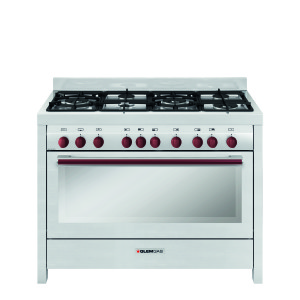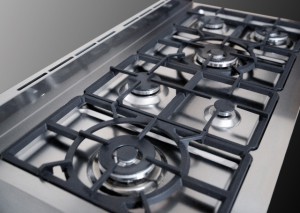Interview with Marco Guerzoni, product manager of Glem Gas: export is 80% of the turnover, 50 are the countries where they distribute, especially kitchens, but the production remains in Italy. Design and details care are the basis of the new products.
By Maria Eva Virga

Creativity, design, beauty, emotion. These are just a few words that Glem Gas, company from San Cesario (Modena), born in 1959, exports to the world to “guarantee” the made-in-Italy quality of its products: historically cookers, ovens, hoods and finally sinks, mixers, refrigerators and built-in dishwashers. An all-Italian commitment to spread a valuable kitchen environment in its totality. Marco Guerzoni, the company product manager, tells to Home Appliances World what it means for Glem to work in the export and anticipates some information about the products.

How important exports is for Glem Gas and what are the main countries for export? The group is definitely oriented towards foreign markets: on a turnover of about 90 million euro, Italy accounts for 20% – and it is market leader in the FS cookers segment, with a share of 16% – of the remaining 80% the most important areas are represented by the Middle East, Australia, Europe, including Russia.
With what products do you reach the 50 countries you collaborate with? Do you have a different offer for Italy and abroad?
We speak mainly of cooking appliances, including the kitchens, that are the heart of our offer, but over the years we are becoming more and more consistent also in the built-in. We have ranges of products dedicated for area: the Middle Eastern area, for example, that acquires more traditional kitchens lines, with dedicated knobs and handles, large, with classical grip and round shapes, or Europe and Australia that, instead, require design products, even extreme. In the various areas we customize the offer according to the market demands, by functional type, for the most demanding, in terms of aesthetics. Our approach is definitely not to impose industrial choices, but the attempt is to meet the market demands making them manufacturable. This without losing sight of the importance of a strong brand and product identity.
On what criteria, do you select modes for distributing abroad? Agreements with chains, importers, branches?
It depends much on the strategic approach to the market. There are some areas in which we directly operate through branch, as in France, Portugal, Australia. Other areas, for history or opportunities, are served through exclusive importers. This does not mean, however, to give a different importance or duration to our collaboration: in fact we have distribution partnerships that last for over 30 years. As in the Middle East, where the distribution of our products already occurred in the 60-70s.
Besides to be synonymous with quality and detail care, it is also convenient to be made-in- Italy?
The main opportunity of producing in Italy is given by the people and the “culture of doing” that our beautiful country inherently offers. Knowing how to reflect these skills in everything we do every day is the hardest part. Succeeding in it makes the difference between making the Italian made-in-Italy brand an excellence in the world, or one among many. We cannot even consider the idea of producing abroad. If we look at the mere cost of labor, it is obvious that producing abroad is cheaper, but here in Italy we can maintain partnerships with suppliers who are used to working with us. Furthermore, our production organization is part of a premium segment: we must necessarily differentiate. Made-in-Italy, the very fact of producing in Italy, however, is still a major appeal for the end customer.
What are the products that you will launch in the short term in Italy and abroad? Which trend do they reflect?
For Italy we are working on two new kitchens aesthetic and some models of built-in ovens. For kitchens it is the completion of an update task of product design, started in 2012 with the introduction of the kitchen Matrix. We worked focusing on distinctive elements in terms of aesthetics and giving a special care to details to provide to the user a new perception of the product. In addition to the aesthetic, we also revised the functional part through the renewal of the oven cavity and improvements that affect both the ease of cleaning and the energy saving. In the built-in we are more focused on the enlargement of the models in the range to seize some opportunities that we believe the market can offer. For the foreign markets, we are launching an innovative product for our offer: it is a 120 cm kitchen with a strong professional appeal.
How important is your choice of materials and innovation for the foreign customers?
In our type of product the metal is king. The steel, in particular, is commonly seen as the more prestigious absolute material. For built-in models over the years even the glass has taken hold, which is synonymous with elegance and clean design. That said, for some years also in Glem is ongoing the experimentation with different materials applied to the world of cooking. The most “extreme” and successful model has been Monofuoco Origine of Progetti line, built-in hob with single burner, composed by three elements: the burner, a ceramic plate (available in different colors) and the command area with its ebony knob. It is really innovative and appreciated worldwide. The trial also received Honorable Mention at the XXII Compasso d’Oro – ADI 2012. Other ideas are “contaminating” us: carbon look finishes, matt paints like cement: at the present moment nothing has come yet to mass production, but we are not very far. We will see what to aim for the next models in design.
You are launching your new kitchen. How important is the design in the new kitchens projects and what are the main innovations that characterize it?
Design is the central part of the development and it often represents the triggering spark from which the new models derive. Among the values of Glem the beauty of what we build is a consolidated ideal since the beginning of our history (1959). Over the years, the classical process of the esthetics definition, which sees as active parts various functions of the company, has evolved towards a more focused approach: since 2008 in fact, we have been constantly collaborating with the BCF Design Studio of Cutino architect, an extremely advantageous partnership because it gives us new ideas and information on new products. So, whenever we think of a new product ,we aim to introduce innovations in several areas: aesthetic and usage, not only as cooking. In recent years we have focused, for example, on full width handles, innovative knobs shapes, perhaps inspired by other commonly used products (like the console of the car). In general, we focused on a lightening of the kitchen design with the intent to make it less “traditional” and more aligned with the new trend of home design. We also worked rethinking various areas: dashboards commands reduced, most elegant grids, new enamels to facilitate the duration, ovens with the possibility of using gas or electricity for cooking … many small details that are often been recognized to us as innovative.
After the excellence in gas cooking, you have dedicated to the production of all appliances in the kitchen environment. Which production do you thing to develop in the future?
For the future I think we will always be on the production of this type of “platforms” (kitchen, built-in oven, built-in hob). We believe that it is necessary to maintain a certain focus also to address in an effective way both economic resources that, especially, the human ones.




